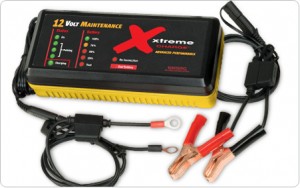Modern motorcycles are amazing. Technology has advanced to the point that nearly all new motorcycles are reliable, and they have good brakes, tires that grip well in the rain and suspension provides a comfortable ride despite our crumbling infrastructure. With 8,000-mile oil change intervals, 24,000-mile valve adjustment intervals and maintenance-free shaft and belt drives, today’s rider—that is, me—can get downright complacent when it comes to keeping a motorcycle running well.
Good thing Editor Tuttle is around to provide guidance on proper care and upkeep. With a warehouse cage burgeoning with motorcycles, every available socket is devoted to maintenance battery chargers. Whereas test bikes have new, maintenance-free batteries, staff and contributor motorcycles—such as Bill Stermer’s ‘70s-era airhead BMW, Clem Salvadori’s mid-80s Yamaha Seca and my bashed-n-thrashed ’98 Kawasaki KLR650—have old-school components and these bikes sometimes sit for months when we’re out testing the latest and greatest.

The good folks at PulseTech recently sent us a five-stage, 12-volt maintenance battery charger, itsXtreme Charge XC100. Designed specifically for motorcycles, once the XC100 is plugged into a 110-220 AC power source and attached to a battery, it tests the battery’s condition. (The XC100 comes with jumper cable-style small battery clamps and a pigtail with terminal connectors, both of which are fuse-protected.) If, after testing, the red “Bad Battery” LED comes on, the battery is non-recoverable, or you’ve accidentally hooked the XC100 up to a 6-volt battery. If the battery is still good, the XC100 will indicate how much charge the battery has: 25, 50, 75 or 100 percent. A green “Charging” light will come on if the battery requires bulk charge. During charging, the XC100 simultaneously runs in “Pulsing” mode, which uses Patented Pulse Technology to minimize the size of lead sulfate crystals so the battery will hold as much charge as possible. Once the battery reaches a full charge, the “Charging” light goes off, the “100%” light comes on and the XC100 provides a continuous float charge while staying in pulse mode. The battery can be left in this mode indefinitely.
Click here to see Xtreme Charge’s instructional YouTube video.
Recently I left the key to Rider’s 1999 Honda GL1500 Gold Wing SE, which is used to schlep gear on photo shoots, in the accessory position overnight and ran down the battery. I was able to jumpstart the bike and get it back to the office, but the battery was weak. The battery was a few years old, and I was concerned it wouldn’t hold a charge. I hooked it up to the XC100 and it ran through the testing sequence. The “Bad Battery” light never came on, and the battery had only a 25% charge. The XC100 automatically went into the bulk charge and pulse modes. When I returned the next morning, the battery was fully charged and ready to go. Once put back in the ‘Wing, it had plenty of juice to start the big 1,500cc engine. Now we keep the Gold Wing hooked up to the XC100 so it will be ready to ride anytime we are.
With the hibernation season approaching, or if you’ve got one or more motorcycles that don’t get ridden as often as they used to, a good maintenance charger is smart investment. The PulseTech Xtreme Charge XC100 is fool-proof and has patented technology to do the dirty work for you. Nothing is more disappointing than getting all suited up for a ride only to discover your bike’s battery is dead. MSRP is $99.95.
For more information, visit www.xtremecharge.com or see your Tucker Rocky, Custom Chrome or Battery Direct dealer. Also available at www.bikebandit.com.
UPDATE 9/24/10
After our initial test, we left the ignition on our Gold Wing in the accessory position overnight (again), and the next morning, of course, the battery was dead. We used the opportunity to further test the Xtreme Charge, but when we hooked it up, it indicated “Bad Battery” and would not charge it. So we put the battery on our big Christie shop charger and it was fine within a few hours. This is the explanation we received from the folks at PulseTech:
“There are a few potential reasons for the results you got. First and possibly the most accurate reason is that the Xtreme has a 6V start up voltage designed in to avoid potential problems with erroneous connection to a 6V battery. So if the battery is drawn down to below 6 volts due to a problem like what you have stated, the unit responds with a bad battery result as noted in the user manual requiring a deeper battery test (note—the manual does not say anything about a deeper battery test, or provide the following).
A response to this would be to give the battery a good test with an appropriate tester and then to get around this either use a manual charger temporarily to ‘jump’ the battery to above 6 volts letting the Xtreme then take over through the charging and conditioning process or use another battery to do the same. The charger has to just momentarily ‘see’ voltage above 6 volts to start up.
Or, the battery is indeed bad having a potentially mild internal short.”
Since our Wing’s battery does not seem to be bad, we can only conclude that the 6V minimum startup voltage required by the Xtreme is what caused our problem with it. You could “fool” the Xtreme under these conditions with something as simple as a small 9V battery to get it to startup, but we note that other popular maintenance chargers have startup voltages as low as 2V, avoiding the problem under most circumstances. On the other hand, if you have a lot of 6V batteries around, the Xtreme might be a good choice.







